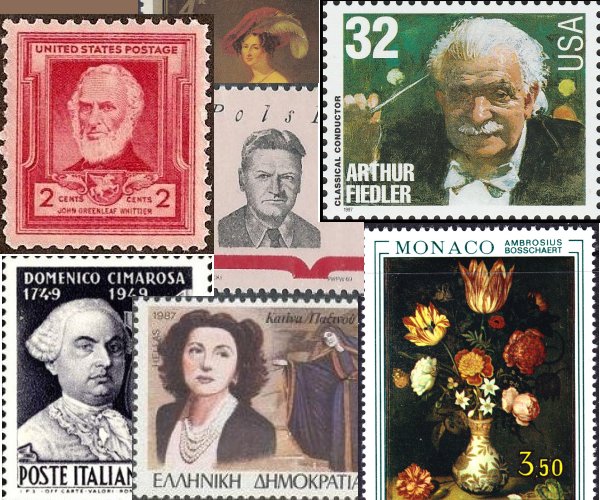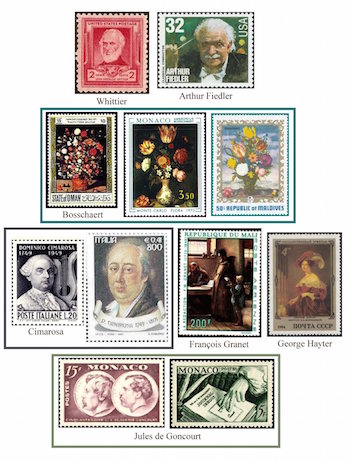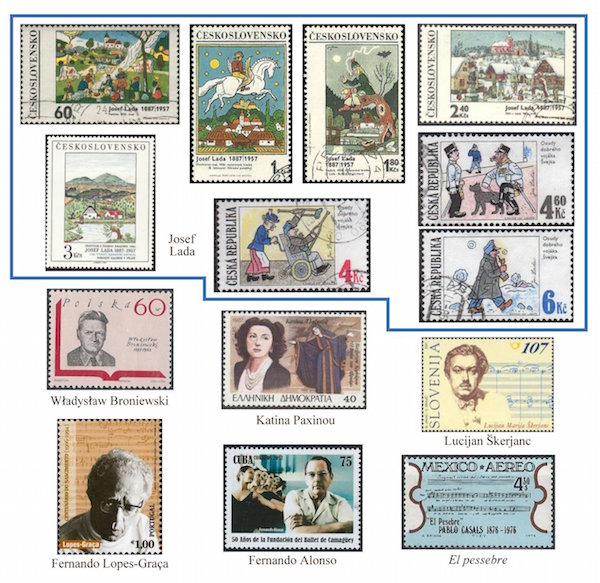The Arts on Stamps of the World — December 17
An Arts Fuse regular feature: the arts on stamps of the world.

By Doug Briscoe
Two Massachusetts boys happen to be our lead figures on this December 17.
John Greenleaf Whittier (1807 – September 7, 1892) was born in Haverhill. He was color-blind. His first poem to see print, submitted secretly by his sister when Whittier was 18, was published in a Newburyport paper edited by William Lloyd Garrison. This introduction would lead to a journalistic association between the two men for some years, though a political difference of opinion would divide them in the late 1830s. Both, of course, were ardently committed abolitionists, and a substantial proportion of Whittier’s poetry dealt with the subject. Otherwise his best known work is the long poem Snow-Bound (1866). Whittier’s words have been set by numerous (mostly American) composers, among them Charles Ives, Gustav Holst, Arthur Foote, Ernst Bacon, and Halsey Stevens.
Arthur Fiedler (1894 – July 10, 1979) is often thought of as the first conductor of the Boston Pops, but in fact he was the eighteenth! (The orchestra had been founded in 1885 as an offshoot of the BSO.) His father Emanuel played violin in the BSO. (I guess there is no relation to the German conductor Max Fiedler.) Although Boston-born and bred, Arthur went with his family back to Austria at the age of 15, moving on to Berlin the following year (1911) and returning to Boston with the outbreak of the First World War. He formed the Boston Sinfonietta in 1924 and starting leading the Pops in 1930, a position he held for half a century. The stamp comes from a set of four honoring American conductors issued in 1997.
Now we broaden our scope beyond the Hub of the Universe, beginning with Flemish floral painter Jan Baptist Bosschaert (the Younger), who was baptized on this day in 1667 in Antwerp. He died there in 1746. His father was a painter (and a baker), but died when Jan was small. It is said that Jan will still illiterate when he was 17, but around that time he was apprenticed to a flower painter named Jan Baptist de Crépu, and it seems that was all it took to give Jan his leg up. Bosschaert’s own paintings are almost exclusively of flowers, but he regularly collaborated with figure artists in allegorical or mythological scenes. Examples of his work are seen on stamps of Oman, Monaco, and the Maldive Islands.
Domenico Cimarosa (17 December 1749 – 11 January 1801) was an Italian composer of operas; he wrote more than eighty of them. A child of poor parents who sent him to a free school, Cimarosa’s intellect was noted, and he received a scholarship to a musical school in Naples. After years of writing operas for that city and others in Italy (he lived for a time in both Rome and Florence), he went at the invitation of Catherine the Great to St. Petersburg, where he remained for four years, composing many works of different kinds, including his fine Requiem in g-minor. From there he moved on to Vienna at the request of Leopold II, and there his masterpiece Il matrimonio segreto was produced in February 1792, just two months after the death of Mozart. Back in Naples, Cimarosa got into hot water for the revolutionary sympathies he had exhibited during the French occupation and died in Venice on his way back to St. Petersburg. I recall with affection an old Westminster mono LP of Robert Veyron-Lacroix playing 32 of Cimarosa’s sonatas on the harpsichord.
The French painter François Granet (17 December 1775 – 21 November 1849) was born in Aix-en-Provence and had a strong inclination to become a painter even in boyhood. In his early 20s he progressed to the studio of Jacques-Louis David in Paris. He lived in Rome from 1802 to 1819 and would frequently return there in later years. His portrait was painted by Ingres in 1807. Granet was associated with the Capuchins, a frequent topic in his work, as in Capuchin Writing a Document (1848), offered on a stamp from Mali.
A contemporary English painter was Sir George Hayter (17 December 1792 – 18 January 1871), the son of a painter of miniatures and a drawing master. The headstrong youth ran off to sea when he was 15 (his father secured his release) and secretly married a 28-year-old woman the next year. He attended the Royal Academy Schools and found favor with George IV’s daughter Princess Charlotte and the nobility. He went to Rome in 1816 and met and may have studied with Canova. Hayter’s painting The Tribute Money (1817) earned him the admiration of Roman art lovers. He executed a great many portraits, including one of the young Queen Victoria (1838), who named him her Principal Painter in Ordinary. He was knighted in 1842. The Russian stamp, one of many delighting in the possessions of the Hermitage, shows Hayter’s Portrait of Countess Elizaveta Vorontsova (1839), who lived from 1792 to 1880.

Jules de Goncourt (17 December 1830 – 20 June 1870) was the younger of the Goncourt brothers, who not only wrote books together but never spent more than a day apart until Jules’s death from a stroke brought on by syphilis (clearly Jules had too much independence). The brothers began their collaborations with books on history, art, and society, with their observations on literature in the lengthy Journal de Goncourt. They began writing novels in 1861 and produced a total of six. In the 26 years after the death of Jules, Edmond went on to write four more novels alone.
Czech illustrator Josef Lada (17 December 1887 – 14 December 1957) was an autodidact who formed his own style drawing caricatures for newspapers and later developed into a painter. His best known work was the illustrations he provided for Jaroslav Hašek’s famous novel The Good Soldier Švejk, though he also worked extensively in children’s literature, also as a writer, having created the talking cat Mikeš. Further, Lada painted frescoes and made costumes for plays and films. A set of four stamps from 1970 shows Autumn (1955), The Remarkable Horse, The Water Sprite, and Children in Winter (1943). For Lada’s centennial in 1987 his Triptych in Bohemian Landscape was reproduced on a stamp, and a group for Hašek’s centenary in 1997 shows three of Lada’s illustrations for The Good Soldier Švejk.
The poetry of Władysław Broniewski (December 17, 1897 – February 10, 1962) is infused with his country’s—and the individual’s—struggle for freedom from oppression. He had first-hand experience as a soldier in both World War I and in the fight against the Soviet invasion that followed. Broniewski (bron-YEFF-ski) published four volumes of poetry between the wars and took up arms again in 1939. For a while he was able to have his poems printed in newspapers under the Soviets, but soon they arrested and imprisoned him for seventeen months. He came to prominence after World War II and translated Dostoyevsky, Yesenin, Mayakovsky, and Brecht into Polish. Fate was not finished with Broniewski; after his daughter died accidentally from gas poisoning he wrote a cycle in her memory called “Anka” but then began to lose himself in alcoholism.
Greek actress Katina Paxinou (17 December 1900 – 22 February 1973) started out as an opera singer, making her debut in 1920 in an opera by Dimitri Mitropoulos. She turned to acting in 1928 and was mostly associated with the theater, though she won both an Oscar and a Golden Globe for Best Supporting Actress for his very first film role in Sam Wood’s For Whom the Bell Tolls (1943), with Gary Cooper and Ingrid Bergman. She continued in films even after making her return to the stage in 1950, notably appearing in Visconti’s Rocco and His Brothers (1960).

Born on precisely the same day as Katina Paxinou was the Slovene composer Lucijan Škerjanc (LOOT-see-ahn SHKAIR-yahnts; 1900 – February 27, 1973), born in Graz. He studied in various cities and taught at the Ljubljana Academy of Music. There are five symphonies and over a dozen concertante works among his orchestral output, five string quartets among the chamber pieces, film music, and a body of piano scores. Škerjanc played piano, violin and clarinet, and wrote music criticism and monographs, as well as a book, From Bach to Shostakovich. The 2001 stamp shows part of the manuscript of his symphonic poem Marenka of 1940.
Portuguese composer Fernando Lopes-Graça (17 December 1906 –November 27, 1994) was also a musicologist who was interested in traditional Portuguese music and harmonized a volume of songs in 1938. Earlier he had been a student of former Liszt pupil Vianna da Motta (1927) and of Charles Koechlin (1937), with whom he studied composition and orchestration. He also completed a Dictionary of Music that had been left incomplete by his teacher Tomás Borba. In 1969, Mstislav Rostropovich played his Concerto da Camera.
Cuban ballet dancer Fernando Alonso (1914 – 27 July 2013) started his career in 1935 and in 1937 moved with his wife Alicia (whose birthday is just four days away) to the US, where in 1940 they joined the American Ballet Theater. They returned to Havana in 1948 and co-founded the Ballet Alicia Alonso, which later evolved into the Cuban National Ballet. Many years later (1975) he became director of the Camagüey Ballet. His full name at birth was Fernando Juan Evangelista Eugenio de Jesús Alonso Rayneri.
One tends not to think of the great cellist Pablo Casals as a composer, but he did write a fair amount of music, including, from his teenaged years, a concerto for cello, piano, and orchestra (1892), a symphonic poem, “La visión de Fray Martín”, and a string quartet (both 1893). Casals also produced a considerable number of sacred choral works, the best known among them being his lovely Christmas oratorio El pessebre (The Manger), which he began in 1943 but didn’t complete until 1960. It was premièred that year on this date in Acapulco. “El Pessebre” was also the name of the house in Ceiba where he and his second wife lived. In 1976, the centenary of Casals’s birth, Mexico issued a stamp quoting the oratorio. His birthday, not incidentally, is coming up on the 29th.
Three writers of note who were born on this date remain unbestamped: Ford Madox Ford (1873 – 26 June 1939), Erskine Caldwell (1903 – April 11, 1987), and the tragically short-lived John Kennedy Toole (1937 – March 26, 1969).
A graduate of the University of Massachusetts with a B.A. in English, Doug Briscoe worked in Boston classical music radio, at WCRB, WGBH, and WBUR, for about 25 years, beginning in 1977. He has the curious distinction of having succeeded Robert J. Lurtsema twice, first as host of WGBH’s weekday morning classical music program in 1993, then as host of the weekend program when Robert J.’s health failed in 2000. Doug also wrote liner notes for several of the late Gunther Schuller’s GM Recordings releases as well as program notes for the Boston Classical Orchestra. For the past few years he’s been posting a Facebook “blog” of classical music on stamps of the world, which has now been expanded to encompass all the arts for The Arts Fuse.
